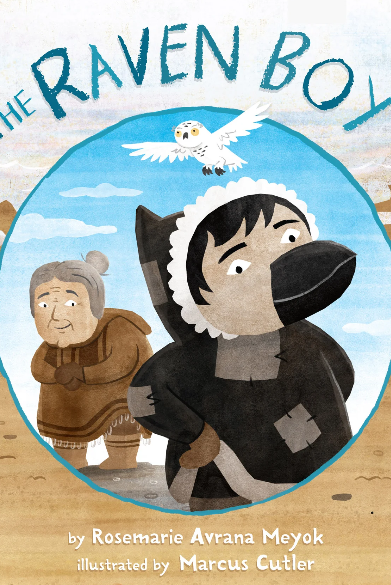The Raven Boy

The Raven Boy
Long ago, Inuit wandered the tundra. There were small family groups that would follow the animals in search of food, and fish at the lakes and rivers.
And old woman lived by herself and had no one to hunt for her. She would beg every hunter in the village for food. But the small bowl she used to collect food became filthy.
One day, she scraped it clean and stirred the dirty meat fat in her mouth, making a small male doll out of it.
She stuck a raven's beak on its face and placed the figurine by the wick of her stone lamp. While she was sleeping, the doll came to life and found a place to lie by her side.
Rosemarie Avrana Meyok, a former Inuinnaqtun teacher, language researcher, and translator, retells this traditional Inuit story from the Western Arctic. Unlike conventional settler stories, The Raven Boy does not have a typical beginning, middle, and end, nor a climax. The raven boy lives in the village and grows up like any Inuit orphan. The old woman makes his clothing from scraps of skin sewn together, and he helps her with chores. He also works with the hunters when they return from hunting and loves to listen to their stories about a strange beast that rises from the ocean's depths but disappears again before anyone can catch it.
The boy follows the hunters and catches the beast which becomes a new piece of land growing from the bottom of the sea. White owls live on this land. The raven boy traps them to get enough skin and feathers for a special outfit. Finally, he needs only one more owl.
The next time he comes to the island, one owl sits in his trap. The owl has a human head and begs the boy to free it, warning that the boy will never get home if he kills it. Ignoring the owl's warning, the raven boy does kill it and uses its skin and feathers to finish his parka. He never does make it home but becomes an island with a white streak on the cliffside, just as the owl had foretold. Students may need some assistance to discuss and understand the meanings of empathy and compassion and how the story’s ending may have differed if the raven boy had those strengths.
Marcus Cutler created this book's simple artwork with its strong brown, blue, and white palette. The pictures provide a clear idea of Western Arctic Inuit life: animal-skin tents, dependence on fish and seals for food for themselves and to feed the sled dogs, and skin kayaks for transportation. I particularly appreciate the inclusion on page 2 of a woman using an amauti to carry her child. Readers can pick up additional cultural information by studying the other illustrations, something that would be easier if the pages were larger.
As a member of the Kanata-Hazeldean Lions Club, Helen Mason buys several hundred books for primary and junior children that the club gives to the clients of the Kanata Food Cupboard on Family Literacy Day each year. She has a background in teaching, writing, and educational publishing.
